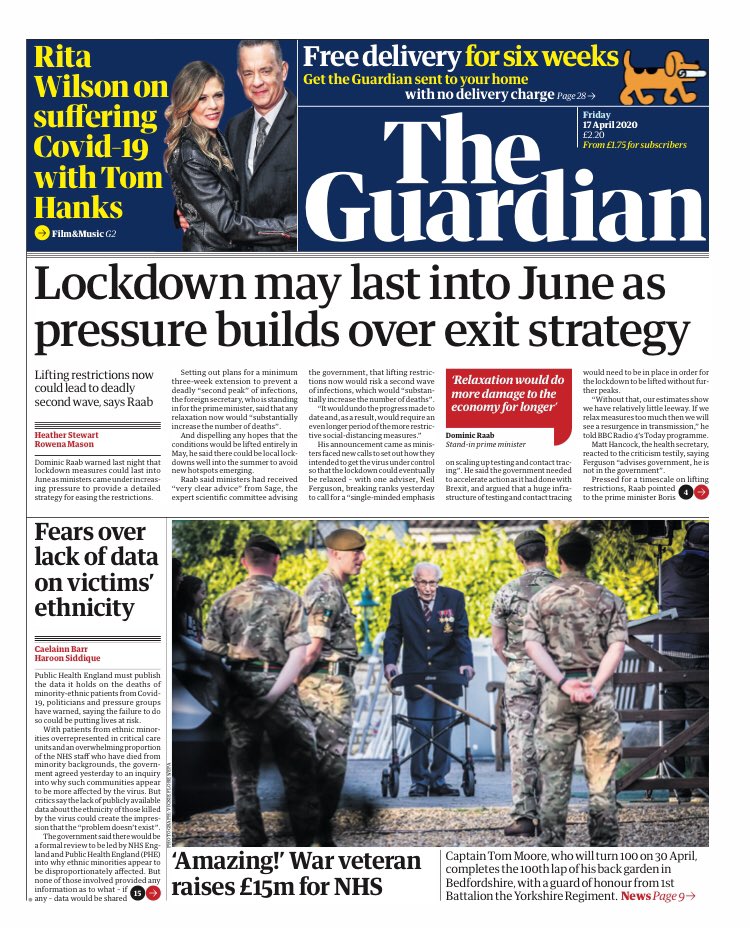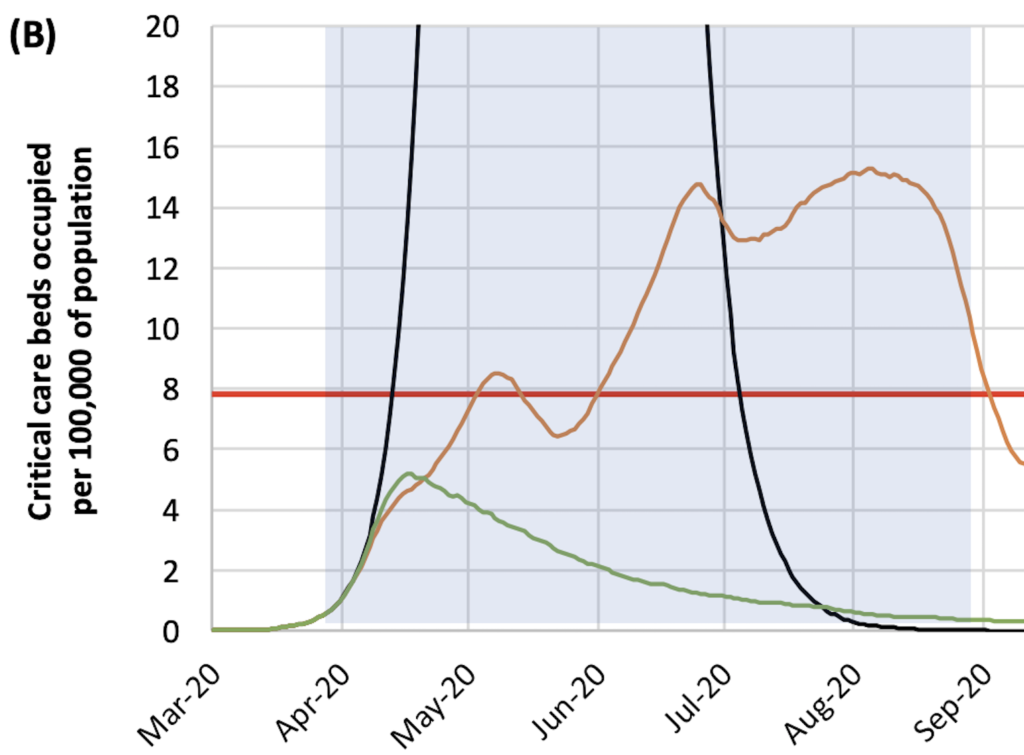
All the broadsheets lead this morning with yesterday’s announcement from Dominic Raab that the lockdown will be extended for at least another three weeks and, in all likelihood, will last for three months from the date it was first imposed (March 23rd), which takes us into June. Raab also set out five “tests” that will have to be met before the lockdown will be lifted: that the NHS is able to provide sufficient critical care to meet demand; “a sustained and consistent fall in the daily death rates from coronavirus so we are confident that we have moved beyond the peak”; “reliable data from SAGE showing that the rate of infection is decreasing to manageable levels across the board”; that the supply of tests and PPE is sufficient to meet demand; and, finally, that any “adjustments to the current measures” won’t risk a second peak of infections that overwhelms the NHS.
The first thing to be said about these five “tests” is that the first, third, fourth and fifth all relate to the capacity of the NHS and its suppliers and could have been combined into a single “test”; only the second is non-NHS related. Would two “tests” have sounded as if the Government wasn’t taking the crisis seriously enough? They’re also frustratingly vague. How is “a sustained and consistent fall in the daily death rates” defined? We’ve seen a “sustained and consistent fall” over the last five days (April 12th – 16th) compared to the previous five days (April 7th – 11th). Does that provide us with sufficient confidence that “we have moved beyond the peak”? Presumably not, but we haven’t been told what will.
As far as assessing the capacity of the NHS is concerned, it would be helpful to know if the Government is still using the March 16th Imperial College model which assumed the NHS’s ICU capacity would remain constant throughout the lockdown period at eight beds per 100,000 of the population. This assumption is represented by the red line below – Fig 3(b) in the Imperial College paper. However, the NHS has significantly increased its critical care capacity since the lockdown began, not least by building new hospitals. Last weekend, we learnt that 37,500 general acute hospital beds were unoccupied, that only 19 patients were being treated at the new 4,000-capacity Nightingale Hospital in the ExCeL, and at least one of the new Nightingales won’t be needed. One reason for that is existing hospitals have been able to double their ICU capacity, according to the Health Service Journal. If you factor all this in, the red line in the diagram below moves above the orange line, which represents the estimated demand for critical care in a less extreme lockdown scenario, with schools and universities remaining open. Based on this, Dominic Raab could have announced yesterday that schools would reopen after the Easter holidays, i.e. on Monday, without any risk of the NHS being overwhelmed. (I’m indebted to a reader, Mike Hearn, for pointing this out.)

The other critical assumptions in the Imperial College model are that <5% of the UK population has been infected and the infection fatality rate (IFR) is 0.9%, both of which are looking increasingly shaky. New data from Robbio in Lombardy reveals that 10 times more people have been infected than was originally thought, with 22% of the population testing positive for antibodies, and a new paper by Mikko Paunio, a Finnish epidemiologist and key scientific advisor to the Finish Government, estimates that the IFR is 0.13%, making the virus roughly as dangerous as seasonal flu. Paunio submitted an earlier version of this paper to a MedRxiv prepublication site, as well as PLOS Medicine, but both rejected it. Consequently, I’ve decided to publish it on this site. If any epidemiologists want to challenge Paunio’s conclusions, feel free to do so in the comments.
One key piece of evidence cited by lockdown zealots is the latest ONS data that show a steep increase in the number of deaths in Week 14 compared to the five-year average. But according to the Times, only half the excess deaths in the week of March 28th – April 3rd were attributable to COVID-19, with the rest due to other causes. The likely reasons for this are delayed referrals for patients with serious conditions (because non-Covid patients have been de-prioritised) and a reluctance on the part of seriously ill people to go to hospital, partly because they’re worried about catching the virus and partly because they don’t want to be an additional burden on the NHS. In other words, the lockdown itself is responsible for about the same number of excess deaths as COVID-19.
There’s also mounting evidence that the lockdown is damaging people’s mental health. An article in Lancet Psychiatry says it’s likely to have a “profound and pervasive” impact on mental health, with two surveys showing many British people had experienced heightened anxiety and fear of becoming mentally unwell since the pandemic struck and are struggling to cope in isolation.
What’s particularly disappointing about the Government’s decision to extend the lockdown – and not announce any scaling back of the extreme social distancing measures – is that it’s increasingly at odds with the approach of other countries. Yesterday, Donald Trump announced guidelines for “Opening up America again”, and Italy and Spain are dialling back their own lockdowns. More generally, those countries that have avoided hard lockdowns have recorded fewer deaths per million – Japan (1.2 coronavirus deaths per million), South Korea (4.3), Singapore (1.8) and Taiwan (0.3) – than those that have effectively placed their citizens under house arrest – Spain (397.6), Italy (358.2), France (256.3) and UK (193.5). For this last bit of data, I’m indebted to Professor Ramesh Thakur, who has written an excellent sceptical essay on the “global lockdown”.
Don’t forget to email me with links to interesting articles, interviews and blog posts, and continue to post comments. If you want to receive this daily update in your email inbox every morning, fill in the form at the top of this page.










To join in with the discussion please make a donation to The Daily Sceptic.
Profanity and abuse will be removed and may lead to a permanent ban.
Risks Of 5G Are Serious – latest leaflet to print at home and deliver to neighbours or forward to politicians, media, friends online.
So far 7 idiot down-voters.
Some people are so anti-science it is incredible.
The combinations of microwave frequencies in 5G are dangerous.
Not sci-fi but sci-fact.
Thursday morning A404 & A4155 Little Marlow Rd Marlow
We were beeped by somebody who looked like the Late Her Majesty. According to a video I saw she’s alive and well and living in Marlow.
Hope you gotta lotta honks!
The two Jameses at New World Next Week highlight the WPATH Files from Environmental Progress, showing that ‘gender medicine’ is neither science or medicine. It is 70 pages of documented child brutality (plus all the evidence) – avoid eating while reading. Link to full document on this page:
https://environmentalprogress.org/big-news/wpath-files
The WPATH Files reveal that WPATH is neither a medical organization nor a scientific organization. The group is engaging in unregulated experiment on some of the most vulnerable individuals in society. The ethical and legal obligation of securing informed consent is being disregarded, and members show little concern for the potential long-term outcomes of patients. Awareness exists among members regarding the debilitating and potentially fatal side effects of experimental hormone therapies. There is evidence that members know puberty blockers are experimental and that young patients lack a comprehensive understanding of the long-term physical and psychological effects of hormonal and surgical interventions, making cognitive consent impossible.
Ralph Nader on the probable – and likely severe – undercount of the death toll in Gaza…..
https://nader.org/2024/03/05/stop-the-worsening-undercount-of-palestinian-casualties-in-gaza/
….on the back of over 100 weapons deliveries from the US (let alone the UK) in the last 150+ days (1.5 deliveries per day)…..
https://truthout.org/articles/report-us-has-secretly-sent-israel-over-100-weapons-shipments-in-last-150-days/
…..which even the WSJ covers (courtesy of Meryl Nass’ substack):
https://merylnass.substack.com/p/wsj-article-verbatim-describes-us?utm_source=profile&utm_medium=reader2
It is so disgusting and nobody cares.
More or less daily there are references to
1) a recent pandemic. Didn’t happen.
2) “covid” “vaccines”. No such thing.
3) “gender critical” views. Made up term designed to make the understanding of reality shared by 99% of the world’s population into some kind of weird cult, whereas the opposite is true.
4) “trans women”. There are men and women, that’s it.
Language matters. I hope new people come to DS every day. I would not like them to think that we accept the corruption of language that our enemies are using to confuse and manipulate.
Hear, hear.
Tucker covers Bidens address to the nation ! Watch it if you can ! It’s diabolical cringe ( The speech not Tucker )
( The speech not Tucker )
“‘Islamophobia’ is being used by Islamists to control debate”- “It is entirely right to call out anti-Muslim hatred”, says Steven Pollard in the Jewish Chronicle.
No, Mr. Pollard, it isn’t. Nobody ever calls out “Anti-Christian Hatred”, so why should Islam or Judaism get special status? The whole concept of “hate speech” is utterly alien to the West, and has no place in western laws.
But you’ll be glad to know that Backstabbing Weasel Gove is about to appoint a new “Islamo-phobia Tsar” (funny how the Communists who murdered the Tsar and his family, even throwing some alive down mine shafts, have now brought that word “Tsar” into English jargon). The new “Tsar” is reported to be Fiyaz Mughal, founder of “Tell Mama”.
Michael Gove to appoint new anti-Muslim hatred adviser ahead of new extremism definition next week (gbnews.com)
You may remember the scandal of “Tell Mama” years ago, when UK Muslims were encouraged to ring the “Helpline” with harrowing tales of Vicious Gangs of White Men rampaging through the streets of their native land, attacking helpless Muslim women and children, ripping off headscarves and raping at will. But just like the harrowing tale of one Muslim man who claimed a gang of British National Party thugs had beaten him up and left him for dead in a forest, all these tales of white people assaulting Muslims were proven by the long-suffering police to be a pack of lies.
You may also remember that this Muslim Mughal (Mughal comes from “Mongol”), was kicked out of Uganda and then Kenya along with all other Indian Subcontinentals by “evil African dictators”, but instead of returning to India, they all swarmed into the West.
You may also remember the reason the Africans of Kenya, Tanzania and Uganda kicked them all out: because they were taking over all the top positions in the government, legal system and business, treating the Indigenous Africans like second-class citizens in their own lands. As the great African leader Jomo Kenyatta, “Father of the Kenyan Nation” explained, “There are too many ticks on the lion’s belly”, before chucking them all out of Kenya, followed by Tanzania and Uganda.
And nobody ever called the Africans “racist” for defending their own people.